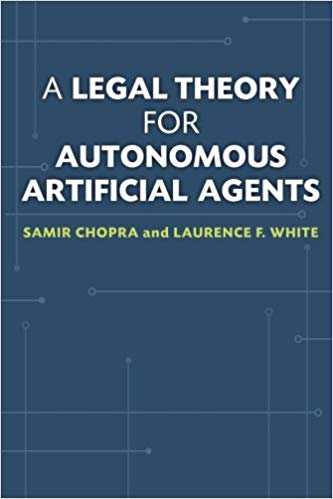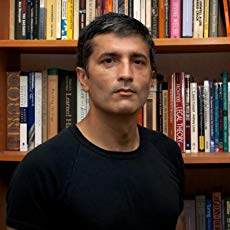Who Does the Concept of “Intellectual Property” Really Benefit?
Was traditional copyright law meant to protect algorithms that decide people’s financial fate?The title question is more complicated than we might at first suppose. The short answer is, not necessarily the starving artist. So says Samir Chopra, a Brooklyn College philosophy professor and co-author with Laurence F. White of A Legal Theory for Autonomous Artificial Agents:
The grand term ‘intellectual property’ covers a lot of ground: the software that runs our lives, the movies we watch, the songs we listen to. But also the credit-scoring algorithms that determine the contours of our futures, the chemical structure and manufacturing processes for life-saving pharmaceutical drugs, even the golden arches of McDonald’s and terms such as ‘Google’. All are supposedly ‘intellectual property’. We are urged, whether by stern warnings on the packaging of our Blu-ray discs or by sonorous pronouncements from media company CEOs, to cease and desist from making unwanted, illegal or improper uses of such ‘property’, not to be ‘pirates’, to show the proper respect for the rights of those who own these things. But what kind of property is this? And why do we refer to such a menagerie with one inclusive term? Samir Chopra, “End intellectual property” at Aeon
I come to this question as a permissions editor from the pre-digital age. I was often surrounded by metre-high piles of paper, in connection with the permissions traded between publishers for large educational projects. Being a writer by trade, I was also a writers’ rights activist in the copyright wars of the early digital age (1990s). But I agree with Prof. Chopra when he summarizes his position: “Copyrights, patents and trademarks are all important, but the term ‘intellectual property’ is nonsensical and pernicious.”
As he notes, the phrase, first used in a legal decision in 1845, lives on in the establishment of the World Intellectual Property Organization, an agency of the UN founded in 1967 to protect copyrights, patents, trademarks, and trade secrets. But these terms refer to four distinct types of ownership and they only began to be lumped all together as “intellectual property” in the digital era. Let’s tease them apart.

If you write a short story, it is copyright to you because you created it. You can sell the right to publish the story to a publisher, in which case the publishing agreement will set out the circumstances under which your rights revert to you. The publisher could, of course, buy all rights; the custom is that you then get a good deal more money for the work than if you were offering only first publication rights (first serial rights). For the record, ideas as such cannot be copyrighted, only the words that give form to the idea.
Patents protect both inventions and detailed ideas for inventions that are under development. Trademarks are art or typography that identifies the source of goods (the illustration of a cow on Cow Brand Baking Soda comes to mind). The secret recipe for Kentucky Fried Chicken, kept in a safe, is an example of a trade secret.
These specialized areas of law encourage new works and inventions and ensure the quality of existing ones by protecting the right of their creators and owners to benefit from them. But they are governed by widely different considerations. As Chopra writes,
Consider the common claim that intellectual property promotes innovation: this is actually true only of patent law. Novels are copyrighted even if they are formulaic, and copyright only incentivises the production of new works as public goods while allowing creators to make a living. These limited rights do not address innovations, which is also true of trademark and trade secret law. Crucially, ‘intellectual property’ is only partially concerned with rewarding creativity (that motivation is found in copyright law alone). Much more than creativity is ‘needed to make a patentable invention’, Stallman explains, while trademark and trade secret law are orthogonal to creativity or its encouragement. Samir Chopra, “End intellectual property” at Aeon
“Orthogonal to creativity” indeed! The whole point about the “secret sauce” is that it does not change from one century to the next. Its “trade secret” protection is hardly meant to encourage innovation.
Dr. Chopra fears that lumping all these time-tested, economy-based rights together as “intellectual property rights” is great rhetoric but results in corporate power grabs: “The resulting legal and economic landscape finds power concentrated in corporations with indefinitely extensible copyright terms, gigantic patent portfolios and politically influential trade secrets – each of which can trigger an endless series of litigious disputes in courts, and induce a chilling effect in the work of artists and innovators, and in the daily affairs of citizens.”
He cites the example of algorithms used to determine credit scores as “intellectual property” that can be withheld from those whose lives they affect. Is the algorithm that determines whether you get a mortgage loan really “intellectual property”? Are there no other issues that might arise around the factors that the public lender includes in an algorithm that decides your fate? What about allegations of prejudice that you cannot check out?:
For years, managers have been using a combination of data as well as their own judgment to determine the eligibility of a mortgage candidate. A recent study shows that African-Americans and Hispanics in certain parts of the country have been denied loans at percentages much higher than that of white Americans. When the same decision process is used to train an algorithm, the same biases are created — only now in an automated form. Carlos Menendez, “Is There Such A Thing As A Prejudiced AI Algorithm?” at Forbes
They’re going to have to come up with something better than calling that algorithm “intellectual property.” We are not, after all, talking about Tom Stoppard’s recent Broadway play, The Hard Problem, where the concept of “copyright” is simple fairness to Tom.
Take heart. There is a law by which any immaterial entity tends to pass eventually into the public domain anyway. When I was a child in Canada in the 1950s, the word we used for the household vacuum was “the electrolux.” That was actually the brand name of a widely used model, Electrolux. But I did not know that until much later. A British friend called her family’s vacuum a “hoover” for the same reason and the verb “to hoover” (a room) appeared in due course. We could, and did, hoover a room with an electrolux.
Purists complained, of course, but the odd thing is, so did brand managers. They took out advertisements in writers’ magazines decades ago, asking writers not to use these coinages in their work because they were“owned” trade names. Yet it’s not clear how I could represent to you authentic dialogue from times and places I have known without using the actual words we used. The brand sponsors made it sound like a form of profanity, but they were fighting a losing battle. It’s hard to stake a material claim in an immaterial realm.
Someone will find a way to publish that algorithm.
See also: Screenwriters’ Jobs Are Not Threatened by AI—Unless the public starts preferring mishmash to creativity
and
Could AI write novels?

